MDI/TDI functionalities in WPF Docking (DockingManager)
18 Feb 202524 minutes to read
The MDI and TDI functionalities are applicable for the Document window in the DockingManager. So Document window can be displayed in both Multiple Document Interface and Tabbed Document Interface.
To change mode for the Document window, set the property ContainerMode with its respective values.
By default, the document state window is in TDI mode, that display child as tabbed document.
NOTE
When the window state is in MDI, child of docking manager will be hosted inside the DocumentContainer. So, user can customize child using DocumentContainer. Refer to this documentation for customizing DocumentContainer.
<syncfusion:DockingManager UseDocumentContainer="True" ContainerMode="TDI">
<ContentControl x:Name="Content1" syncfusion:DockingManager.Header="Document1" />
<ContentControl syncfusion:DockingManager.Header="Document2" syncfusion:DockingManager.State="Document" />
</syncfusion:DockingManager>SyncDockingManager.UseDocumentContainer = true;
SyncDockingManager.ContainerMode = DocumentContainerMode.TDI;
DockingManager.SetState(Document1, DockState.Document);
DockingManager.SetState(Document2, DockState.Document);
To make the document child window as MDI document, set the ContainerMode as MDI
<syncfusion:DockingManager x:Name="DockingManager1" UseDocumentContainer="True" ContainerMode="MDI">
<ContentControl x:Name="Content1" syncfusion:DockingManager.Header="Document1" syncfusion:DockingManager.State="Document"/>
<ContentControl x:Name="Content2" syncfusion:DockingManager.Header="Document2" syncfusion:DockingManager.State="Document"/>
</syncfusion:DockingManager>//Tabbed Document Interface.
SyncDockingManager.ContainerMode = DocumentContainerMode.MDI;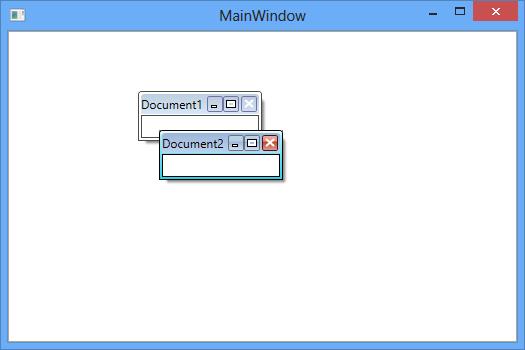
Setting MDI Window state
The state of the MDI Window can be set using the SetMDIWindowState method of DocumentContainer.
Setting MDI WindowState as Minimized
DocumentContainer.SetMDIWindowState(Content1,MDIWindowState.Minimized);DocumentContainer.SetMDIWindowState(Content1,MDIWindowState.Minimized)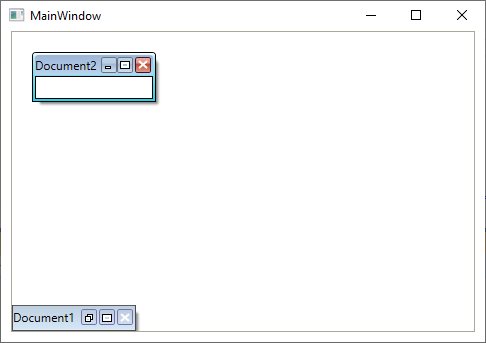
Setting MDI WindowState as Maximized
DocumentContainer.SetMDIWindowState(Content1,MDIWindowState.Maximized);DocumentContainer.SetMDIWindowState(Content1,MDIWindowState.Maximized)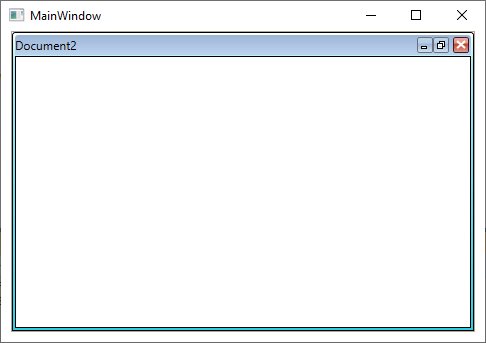
Getting state of the MDI window
The state of the MDI window can be detect using the GetMDIWindowState method of DocumentContainer.
DocumentContainer.GetMDIWindowState(Content1);DocumentContainer.GetMDIWindowState(Content1)Detecting the maximized state of the MDI window
Maximized state of the MDI Container can get by IsInMDIMaximizedState property of DocumentContainer. The container can be fetched from the DockingManager using the DocContainer property.
(DockingManager1.DocContainer as DocumentContainer).IsInMDIMaximizedState = true;TryCast(DockingManager1.DocContainer, DocumentContainer).IsInMDIMaximizedState = TrueResizing MDI
MDI document window can be able to resize using the navigation arrows. To restrict resizing the MDI document windows, disable the Property IsAllowMDIResize of the DocumentContainer that can be get using the DocContainer property of the DockingManager. By default, its values is True.
(DockingManager1.DocContainer as DocumentContainer).IsAllowMDIResize = false;TryCast(DockingManager1.DocContainer, DocumentContainer).IsAllowMDIResize = FalseClosing TDI tab items on mouse middle click
You can close the document windows by clicking the mouse middle button on the document header. You can enable it by using the CloseTabOnMiddleClick property as true and the ContainerMode is set to TDI and CanClose property as true. The default value of CloseTabOnMiddleClick property is false.
<syncfusion:DockingManager x:Name="DockingManager1"
UseDocumentContainer="True"
ContainerMode="TDI"
CloseTabOnMiddleClick="True">
<ContentControl x:Name="Content1"
syncfusion:DockingManager.Header="Document1"
syncfusion:DockingManager.State="Document"
syncfusion:DockingManager.CanClose="True"/>
</syncfusion:DockingManager>this.DockingManager1.CloseTabOnMiddleClick = true;Different Keyboard Navigation Modes
DockingManager allows to navigate between children (Both TDI and MDI) windows easily using the keyboard keys with combination of CTRL + TAB in five different modes by SwitchMode property of the DockingManager.
There are five switch modes.
- Immediate
- List
- QuickTabs
- VS2005
- Vista Flip
Immediate – Switch the MDI document windows immediately.
DockingManager1.SwitchMode =SwitchMode.Immediate;DockingManager1.SwitchMode =SwitchMode.Immediate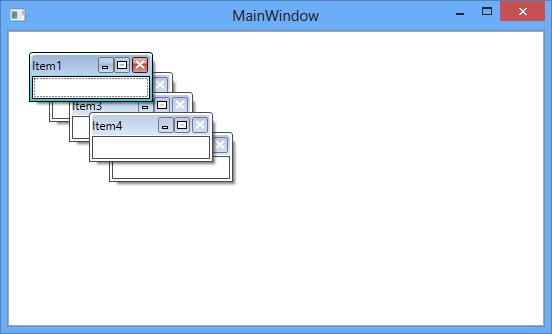
List – Switch the MDI document windows in list format.
DockingManager1.SwitchMode = SwitchMode.List;DockingManager1.SwitchMode =SwitchMode.List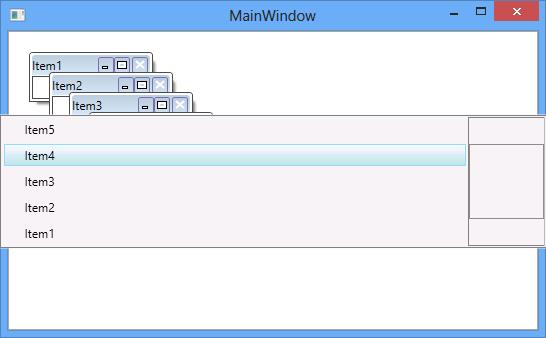
QuickTabs
DockingManager1.SwitchMode = SwitchMode.QuickTabs;DockingManager1.SwitchMode =SwitchMode.QuickTabs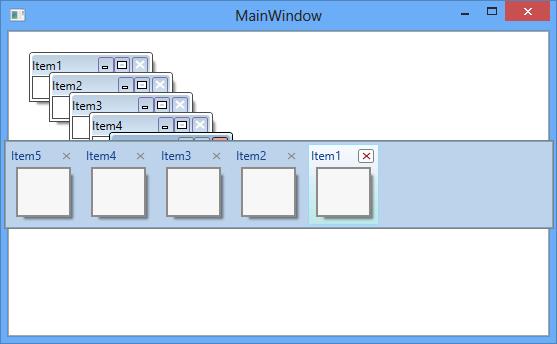
VistaFlip
DockingManager1.SwitchMode = SwitchMode.VistaFlip;DockingManager1.SwitchMode =SwitchMode.VistaFlip
VS2005
DockingManager1.SwitchMode = SwitchMode.VS2005;DockingManager1.SwitchMode =SwitchMode.VS2005
Setting MDI Layout
DockingManager allows to set the different layout for the MDI windows with the different MDILayout values such as Horizontal , Vertical and Cascade layout through the SetLayout method of DocumentContainer.
Horizontal - Arranges the MDI windows horizontally.
void DocumentContainer_Loaded(object sender, RoutedEventArgs e)
{
(DockingManager1.DocContainer as DocumentContainer).SetLayout(MDILayout.Horizontal);
}Private Sub DocumentContainer_Loaded(ByVal sender As Object, ByVal e As RoutedEventArgs)
TryCast(DockingManager1.DocContainer, DocumentContainer).SetLayout(MDILayout.Horizontal)
End Sub
Vertical – Arranges the MDI windows vertically.
void DocumentContainer_Loaded(object sender, RoutedEventArgs e)
{
(DockingManager1.DocContainer as DocumentContainer).SetLayout(MDILayout.Vertical);
}Private Sub DocumentContainer_Loaded(ByVal sender As Object, ByVal e As RoutedEventArgs)
TryCast(DockingManager1.DocContainer, DocumentContainer).SetLayout(MDILayout.Vertical)
End Sub
Cascade - Arranges the layout in a cascade manner.
void DocumentContainer_Loaded(object sender, RoutedEventArgs e)
{
(DockingManager1.DocContainer as DocumentContainer).SetLayout(MDILayout.Vertical);
}Private Sub DocumentContainer_Loaded(ByVal sender As Object, ByVal e As RoutedEventArgs)
TryCast(DockingManager1.DocContainer, DocumentContainer).SetLayout(MDILayout.Vertical)
End Sub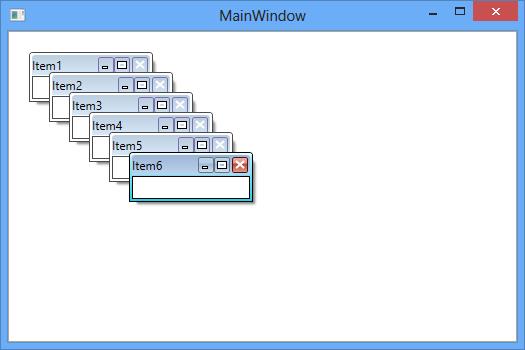
Closing a MDI Windows
To enable or disable closing functionality of the MDI windows, set CanClose an attached property of DockingManager with its respective values. By default, its value is True
<syncfusion:DockingManager x:Name="DockingManager1" UseDocumentContainer="True" ContainerMode="MDI">
<ContentControl x:Name="Content1" syncfusion:DockingManager.Header="Item1"
syncfusion:DockingManager.State="Document" syncfusion:DockingManager.CanClose="False"/>
</syncfusion:DockingManager>DockingManager.SetCanClose(Content1, false);
Indexing an Item in TDI
A document window can be placed at different index position using the SetTDIIndex method of the TDILayoutPanel.
<syncfusion:DockingManager x:Name="DockingManager1" UseDocumentContainer="True">
<ContentControl x:Name="Content1" syncfusion:DockingManager.Header="Document1" syncfusion:DockingManager.State="Document"/>
<ContentControl x:Name="Content2" syncfusion:DockingManager.Header="Document2" syncfusion:DockingManager.State="Document"/>
</syncfusion:DockingManager>TDILayoutPanel.SetTDIIndex(Content1,0);TDILayoutPanel.SetTDIIndex(Content1,0)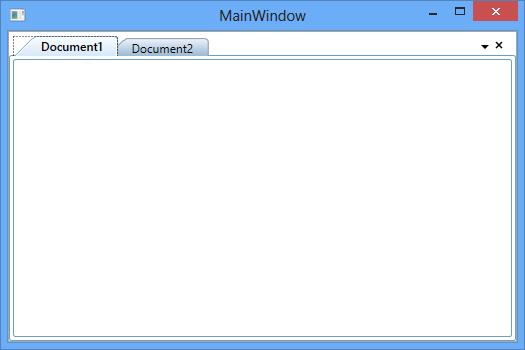
Drag / Drop support in TDI
The TDI document index can be changed by dragging and dropping it like Visual Studio. This functionality can be enabled or disabled through the property IsTDIDragDropEnabled of DockingManager.
<syncfusion:DockingManager UseDocumentContainer="True" IsTDIDragDropEnabled="True" >
<ContentControl syncfusion:DockingManager.Header="Document1" syncfusion:DockingManager.State="Document"/>
<ContentControl syncfusion:DockingManager.Header="Document2" syncfusion:DockingManager.State="Document"/>
<ContentControl syncfusion:DockingManager.Header="Document3" syncfusion:DockingManager.State="Document"/>
</syncfusion:DockingManager>SyncDockingManager.IsTDIDragDropEnabled = true;Rearrange position of document items with auto scrolling
You can easily move or rearrange TDI document items when there are several document items by setting the EnableAutoScroll property value as true. Drag the required document item to overflow button (with three dots) or tab scroll buttons to autoscroll.
The default value of EnableAutoScroll property is false.
<syncfusion:DockingManager x:Name="dockingManager" EnableAutoScroll="True" UseDocumentContainer="True" >
<ContentControl syncfusion:DockingManager.Header="Document1" syncfusion:DockingManager.State="Document" />
<ContentControl syncfusion:DockingManager.Header="Document2" syncfusion:DockingManager.State="Document" />
<ContentControl syncfusion:DockingManager.Header="Document3" syncfusion:DockingManager.State="Document" />
<ContentControl syncfusion:DockingManager.Header="Document4" syncfusion:DockingManager.State="Document" />
<ContentControl syncfusion:DockingManager.Header="Document5" syncfusion:DockingManager.State="Document" />
<ContentControl syncfusion:DockingManager.Header="Document6" syncfusion:DockingManager.State="Document" />
<ContentControl syncfusion:DockingManager.Header="Document7" syncfusion:DockingManager.State="Document" />
</syncfusion:DockingManager>DockingManager dockingManager = new DockingManager();
dockingManager.UseDocumentContainer = true;
dockingManager.EnableAutoScroll = true;
TDI window’s order changed notification
You will be notified when the TDI item’s order is changed by using the DocumentTabOrderChanged event. You can get the order changed TDI window with its old and new index values by using the SourceTabItem, OldIndex and NewIndex properties. You can also get old and new tab group of the order changed item by using the the SourceTabGroup and TargetTabGroup properties.
NOTE
You will also be notified when creating a horizontal or vertical tab groups using
ContextMenuor move the tab document to previous or next tab groups and when tab the float window to Document Window or create new tabgroup using DragProviders.
<syncfusion:DockingManager DocumentTabOrderChanged="DockingManager_DocumentTabOrderChanged"
UseDocumentContainer="UseDocumentContainer"
Name="dockingManager">
<ContentControl syncfusion:DockingManager.Header="Document1"
syncfusion:DockingManager.State="Document"/>
<ContentControl syncfusion:DockingManager.Header="Document2"
syncfusion:DockingManager.State="Document"/>
<ContentControl syncfusion:DockingManager.Header="Document3"
syncfusion:DockingManager.State="Document"/>
</syncfusion:DockingManager>documentcontainer1.UseDocumentContainer = true;
dockingManager.DocumentTabOrderChanged += DockingManager_DocumentTabOrderChanged;You can handle the event as follows,
private void DockingManager_DocumentTabOrderChanged(object sender, DocumentTabOrderChangedEventArgs e)
{
var drag_Drop_Item = e.TargetTabGroup;
//Get the old and new index of the SourceTabItem
var oldIndex = e.OldIndex;
var newIndex = e.NewIndex;
//Get the old and new tab group of the SourceTabItem
var sourceTabGroup = e.SourceTabGroup;
var targetTabGroup = e.TargetTabGroup;
}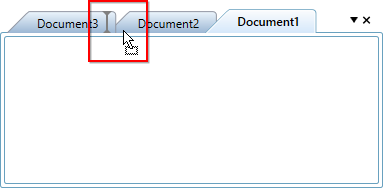
NOTE
Restrict TDI window reordering
If you want to restrict the user to reordering the TDI window by drag and drop operation, use the DocumentTabOrderChanging event and set Cancel property value as true.
NOTE
You can handle the document window will be floated or not by
DockStateChangingEventinstead ofDocumentTabOrderChanging.
<syncfusion:DockingManager DocumentTabOrderChanging="DockingManager_DocumentTabOrderChanging"
UseDocumentContainer="True"
Name="dockingManager">
<ContentControl syncfusion:DockingManager.Header="Document1"
syncfusion:DockingManager.State="Document"/>
<ContentControl syncfusion:DockingManager.Header="Document2"
syncfusion:DockingManager.State="Document"/>
<ContentControl syncfusion:DockingManager.Header="Document3"
syncfusion:DockingManager.State="Document"/>
</syncfusion:DockingManager>dockingManager.UseDocumentContainer = true;
dockingManager.DocumentTabOrderChanging += DockingManager_DocumentTabOrderChanging;You can handle the event as follows,
private void DockingManager_DocumentTabOrderChanging(object sender, DocumentTabOrderChangingEventArgs e)
{
// Restrict the TDI window re-ordering
e.Cancel = true;
}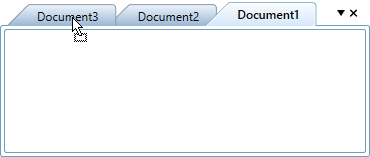
NOTE
Customizing Close Menu
Menu items like Close, CloseAll and CloseAllButThis are available for the document window when two or more documents used in the DockingManager. To collapse the visibility of these menu item, set the property ShowCloseMenuItem, ShowCloseAllMenuItem and ShowCloseAllButThisMenuItem as False.
<ContentControl syncfusion:DockingManager.Header="Item1"
syncfusion:DockingManager.State="Document"
syncfusion:DockingManager.ShowCloseMenuItem="False"
syncfusion:DockingManager.ShowCloseAllMenuItem="False"
syncfusion:DockingManager.ShowCloseAllButThisMenuItem="False"/>
<ContentControl syncfusion:DockingManager.Header="Item2"
syncfusion:DockingManager.State="Document"
syncfusion:DockingManager.ShowCloseMenuItem="False"
syncfusion:DockingManager.ShowCloseAllMenuItem="False"
syncfusion:DockingManager.ShowCloseAllButThisMenuItem="False"/>//Closing Customization
DockingManager.SetShowCloseMenuItem(Item1, false);
DockingManager.SetShowCloseAllMenuItem(Item1, false);
DockingManager.SetShowCloseAllButThisMenuItem(Item1, false);
DockingManager.SetShowCloseMenuItem(Item2, false);
DockingManager.SetShowCloseAllMenuItem(Item2, false);
DockingManager.SetShowCloseAllButThisMenuItem(Item2, false);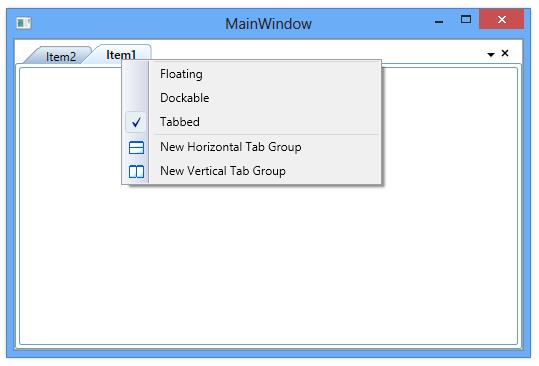
Creating Document Tab Group
TDI document can be grouped like VisualStudio. It can be grouped by drag and Drop and also using the options in context menu items.
TabGroup creation using ContextMenu option
In DockingManager, new tab group can be created at horizontal or vertical side in the document area using ContextMenu option.
Creating Vertical Tab Group
To create a vertical tab group in the Tabbed document, select the “New Vertical Tab Group” context menu item and also it can be created programmatically by calling the method CreateVerticalTabGroup of the DocumentContainer.
(DockingManager1.DocContainer as DocumentContainer).CreateVerticalTabGroup(Content1);TryCast(DockingManager1.DocContainer, DocumentContainer).CreateVerticalTabGroup(Content1)Creating Horizontal Tab Group
To create a horizontal tab group in the Tabbed document, select the “New Horizontal Tab Group context menu item and also it can be created programmatically by calling the method CreateHorizontalTabGroup of the DocumentContainer.
(DockingManager1.DocContainer as DocumentContainer).CreateHorizontalTabGroup(Content1);TryCast(DockingManager1.DocContainer, DocumentContainer).CreateHorizontalTabGroup(Content1)Adding Tab in a Group
In TDI document, new tab group can be created by dragging the tab item into the Document area and click the “New Tab Group” menu item from context menu item.


Adding a new Tab using NewButtonClick event
The NewButtonClick event is used to notify DockingManager when a new button (+) is clicked. By utilizing this event, a new tab can be added at runtime.
<syncfusion:DockingManager x:Name="dockingManager" NewButtonClick="dockingManager_NewButtonClick">
<ContentControl syncfusion:DockingManager.Header="Item2"
syncfusion:DockingManager.State="Document"/>
<ContentControl syncfusion:DockingManager.Header="Item1"
syncfusion:DockingManager.State="Document"/>
<!--Adding new button in docking manager using xaml-->
<syncfusion:DockingManager.DocumentTabControlStyle>
<Style TargetType="{x:Type syncfusion:TabControlExt}">
<Setter Property="IsNewButtonEnabled" Value="True"/>
<Setter Property="NewButtonBackground" Value="Transparent"/>
<Setter Property="NewButtonAlignment" Value="Last"/>
<Setter Property="IsNewButtonClosedonNoChild" Value="False"/>
</Style>
</syncfusion:DockingManager.DocumentTabControlStyle>
</syncfusion:DockingManager>//Adding a new item using the NewButtonClick event.
private void dockingManager_NewButtonClick(object sender, EventArgs e)
{
DocumentTabControl tabControlExt = (DocumentTabControl)sender;
ContentControl contentControl = new ContentControl();
DockingManager.SetHeader(contentControl, "New Item");
DockingManager.SetState(contentControl, DockState.Document);
tabControlExt.Container.AddTabDocumentAtLast = true;
dockingManager.Children.Add(contentControl);
}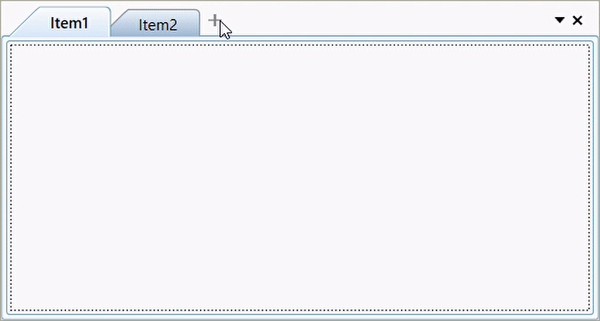
Disable TabGroups
Vertical and Horizontal Tab Grouping feature can be enabled or disabled using the property TabGroupEnabled in DockingManager.
To disabling Tab Groups, set TabGroupEnabled as False. So it does not display “New Horizontal Tab Group” and “New Vertical Tab Group” context menu items even when ShowHorizontalTabGroupMenuItem is true. Drag and drop support to create new tab group is also restricted.
<syncfusion:DockingManager TabGroupEnabled="False" />SyncDockingManager.TabGroupEnabled = false;VS2010 Behavior of TDI
TDI document of DockingManager can be changed to Float while dragging its TDI header. This functionality can be enabled or disabled using the property IsVs2010DraggingEnabled. By default, its value is True.
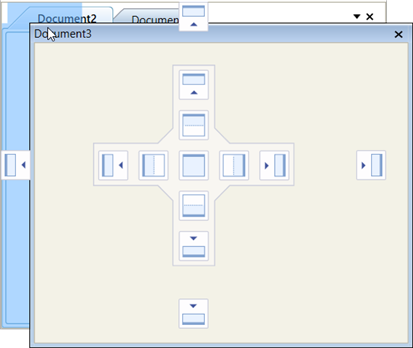
<syncfusion:DockingManager Name="SyncDockingManager" UseDocumentContainer="True" IsVS2010DraggingEnabled="False">
<ContentControl syncfusion:DockingManager.Header="Document1" syncfusion:DockingManager.State="Document" />
<ContentControl syncfusion:DockingManager.Header="Document2" syncfusion:DockingManager.State="Document" />
<ContentControl syncfusion:DockingManager.Header="Document3" syncfusion:DockingManager.State="Document" />
</syncfusion:DockingManager>SyncDockingManager.IsVS2010DraggingEnabled = false;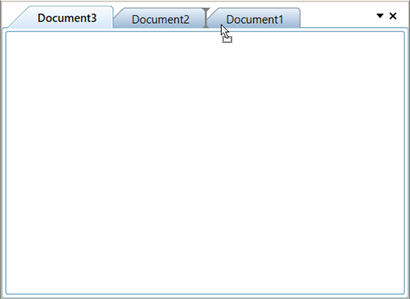
TDI Header Renaming Support
To enable the functionality of editing the TDI document header when double click on document header at runtime, set the property EnableDocumentTabHeaderEdit of the DockingManager as True. By default, its value is False.
<syncfusion:DockingManager UseDocumentContainer="True" EnableDocumentTabHeaderEdit="True">SyncDockingManager.EnableDocumentTabHeaderEdit = true;Hiding TDI Header
To hide the TDI document header when a single document child present in a DockingManager set the property HideTDIHeaderOnSingleChild as True. By default its value is False.
<syncfusion:DockingManager UseDocumentContainer="True" HideTDIHeaderOnSingleChild="True">
<ContentControl syncfusion:DockingManager.Header="Document1" syncfusion:DockingManager.State="Document" />
</syncfusion:DockingManager>SyncDockingManager.HideTDIHeaderOnSingleChild = true;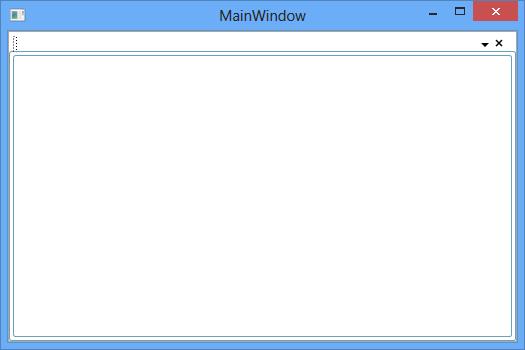
Pin and Unpin tab items
The following section explains the Pin and Unpin tab items in DockingManager.
Enabling/disabling pinning behavior
The AllowPin attached property of DocumentContainer decides whether the document tab item could be pinnable or not. The corresponding tab item will be pinned when the property AllowPin is true. When this property is set to false, the pin and unpin behaviors of document tab item will be disabled. The default value of the AllowPin property is false.
<syncfusion:DockingManager Grid.Row="1" x:Name="DockingManager" UseDocumentContainer="True">
<!-- Output dock window -->
<ContentControl Name="Output"
syncfusion:DockingManager.Header="Output"
syncfusion:DockingManager.SideInDockedMode="Bottom"
syncfusion:DockingManager.DesiredHeightInDockedMode="200"
>
</ContentControl>
<!-- SolutionExplorer dock window -->
<ContentControl Name="SolutionExplorer"
syncfusion:DockingManager.Header="Solution Explorer"
syncfusion:DockingManager.SideInDockedMode="Right"
syncfusion:DockingManager.DesiredWidthInDockedMode="300"
>
</ContentControl>
<!-- ClassView dock window -->
<!-- Toolbox dock window -->
<ContentControl Name="Toolbox"
syncfusion:DockingManager.Header="Toolbox"
syncfusion:DockingManager.State="Dock"
HorizontalContentAlignment="Left"
syncfusion:DockingManager.DesiredWidthInDockedMode="250"
>
</ContentControl>
<!-- Features dock window -->
<ContentControl Name="Features"
syncfusion:DockingManager.Header="Features"
syncfusion:DockingManager.State="Document"
syncfusion:DocumentContainer.AllowPin="True"
>
</ContentControl>
<!-- Docking dock window -->
<ContentControl Name="Docking"
syncfusion:DockingManager.Header="Docking"
syncfusion:DockingManager.State="Document"
syncfusion:DocumentContainer.AllowPin="True"
>
</ContentControl>
</syncfusion:DockingManager>Pin and Unpin tab items using PinButton
The PinButton will be visible in the document tabs only when the property ShowPin is true. The default value of the property is false, so the PinButton will be collapsed from the header panel of the document tab item.
<syncfusion:DockingManager Grid.Row="1" x:Name="DockingManager" UseDocumentContainer="True">
<!-- Output dock window -->
<ContentControl Name="Output"
syncfusion:DockingManager.Header="Output"
syncfusion:DockingManager.SideInDockedMode="Bottom"
syncfusion:DockingManager.DesiredHeightInDockedMode="200"
>
</ContentControl>
<!-- SolutionExplorer dock window -->
<ContentControl Name="SolutionExplorer"
syncfusion:DockingManager.Header="Solution Explorer"
syncfusion:DockingManager.SideInDockedMode="Right"
syncfusion:DockingManager.DesiredWidthInDockedMode="300"
>
</ContentControl>
<!-- ClassView dock window -->
<!-- Toolbox dock window -->
<ContentControl Name="Toolbox"
syncfusion:DockingManager.Header="Toolbox"
syncfusion:DockingManager.State="Dock"
HorizontalContentAlignment="Left"
syncfusion:DockingManager.DesiredWidthInDockedMode="250"
>
</ContentControl>
<!-- Features dock window -->
<ContentControl Name="Features"
syncfusion:DockingManager.Header="Features"
syncfusion:DockingManager.State="Document"
syncfusion:DocumentContainer.AllowPin="True"
syncfusion:DocumentContainer.ShowPin="True"
>
</ContentControl>
<!-- Docking dock window -->
<ContentControl Name="Docking"
syncfusion:DockingManager.Header="Docking"
syncfusion:DockingManager.State="Document"
syncfusion:DocumentContainer.AllowPin="False"
syncfusion:DocumentContainer.ShowPin="True"
>
</ContentControl>
</syncfusion:DockingManager>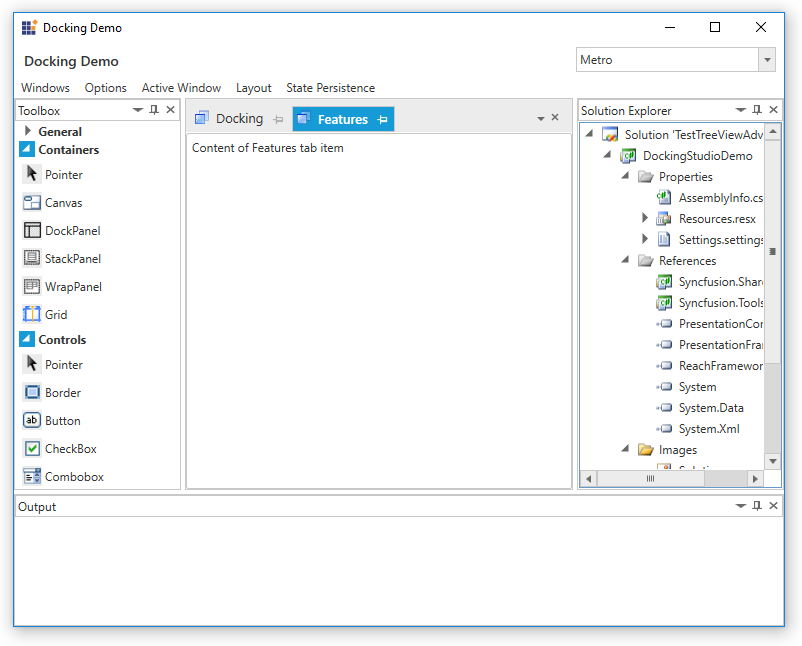
If the property AllowPin is true, the pin button will be enabled and visible. If the property ShowPin is true and AllowPin is false, pin button will be displayed as disabled button.
Functionality of PinButton
When the pin button of the document tab item is visible, the corresponding document tab item can be pinned or unpinned from the DockingManager. When the corresponding document tab item is pinned, it will be inserted at first position of the document tab items collection(if the pinned tab item collection has zero count. Otherwise, the pinned tab item will be added to the existing collection). When the document tab item is unpinned, it will be removed from the pinned tab item collection and added to the first position of the unpinned tab item collection.
Pin and Unpin the tab items programmatically
document tab items can be pinned or unpinned from the DocumentContainer using IsPinned attached property of DocumentContainer. If the property IsPinned is set to true, the corresponding item will be added to respective index. Also,if the property IsPinned is set as false, the tab item will be removed from pinned collection and added to unpinned tab item collection. The default value of the property is False.
Pin and Unpin tab items through ContextMenu
The pin or unpin operations can be done through document tab item’s ContextMenu also. If the property AllowPin is true, and the document tab item is not pinned, the “Pin Tab” option will be visible. If the document tab item is pinned already, “Unpin Tab” will be visible.
<syncfusion:DocumentContainer
Name="DocContainer"
Mode="TDI">
<syncfusion:DocumentContainer.Icon>
<ImageBrush ImageSource="document.png"/>
</syncfusion:DocumentContainer.Icon>
<!--TDI/MDI Children elements of the Document Container-->
<FlowDocumentScrollViewer
syncfusion:DocumentContainer.AllowPin="True"
syncfusion:DocumentContainer.Header="Document Container">
<FlowDocument FontFamily="Calibri" FontSize="13" TextAlignment="Left">
<Paragraph FontWeight="Bold" FontSize="15" TextAlignment="Center">
Syncfusion WPF Document Container</Paragraph>
<Paragraph>This sample exhibits the special features
of the Syncfusion Document Container Control for
Windows Presentation Foundation(WPF).
</Paragraph>
<Paragraph>View this document to experience the features of the
Document Container.Document Container supports both TDI and MDI.
</Paragraph>
<Paragraph>On certain occasions, users may need the data to be contained in
the traditional MDI(Multiple Document Interface) and others where constant
comparison needs to be made between the documents requires a
TDI(Tabbed Document Interface).</Paragraph>
</FlowDocument>
</FlowDocumentScrollViewer>
<FlowDocumentScrollViewer
syncfusion:DocumentContainer.AllowPin="True"
syncfusion:DocumentContainer.Header="Features" >
<FlowDocument FontFamily="Calibri" FontSize="13" TextAlignment="Left" >
<Paragraph FontWeight="Bold" FontSize="15" TextAlignment="Center">Document
Container-Features</Paragraph>
<Paragraph>Document container comes with a set of features. They include
</Paragraph>
<List>
<ListItem>
<Paragraph>Provides options for both MDI and TDI container Mode
</Paragraph>
</ListItem>
<ListItem>
<Paragraph>Various window switching styles. Ctrl+tab could be used
to easily navigate through the windows</Paragraph>
</ListItem>
<ListItem>
<Paragraph>Skins Support</Paragraph>
</ListItem>
<ListItem>
<Paragraph>State Persistence. Document container can be used to
load, save data in IS, BIN and in XML</Paragraph>
</ListItem>
<ListItem>
<Paragraph>Huge set of properties, methods and events for easy
customization</Paragraph>
</ListItem>
<ListItem>
<Paragraph>Document container can be resized and moved using the keyboard.
</Paragraph>
</ListItem>
</List>
</FlowDocument>
</FlowDocumentScrollViewer >
<FlowDocumentScrollViewer
syncfusion:DocumentContainer.AllowPin="True"
syncfusion:DocumentContainer.Header="Window 1" >
<FlowDocument FontFamily="Calibri" FontSize="13" TextAlignment="Left">
<Paragraph>For ease of navigation, users can switch between the MDI and TDI modes.
</Paragraph>
<Paragraph>Most users prefers keyboard to mouse navigation. Thus, to
satisfy all users, syncfusion Document Container is boosted by
Window Switcher(CTRL+TAB keys) for smooth, fine and flexible navigation
between interfaced windows. syncfusion ships five different modes of window
switchers.
</Paragraph>
<Paragraph>
Hold down the CTRL key and use the TAB keystroke repeatedly to
experience active switchers in effect.
</Paragraph>
</FlowDocument>
</FlowDocumentScrollViewer>
</syncfusion:DocumentContainer>The following images illustrates the same,
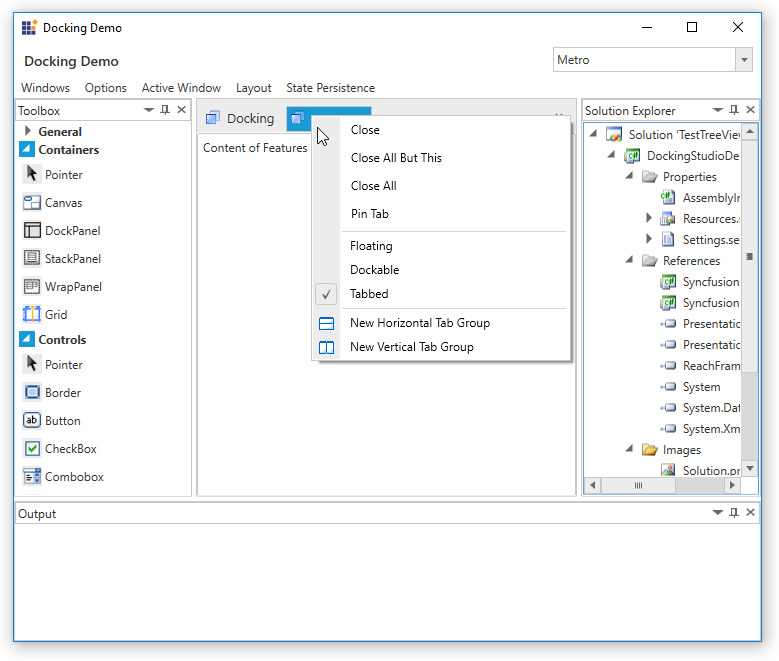
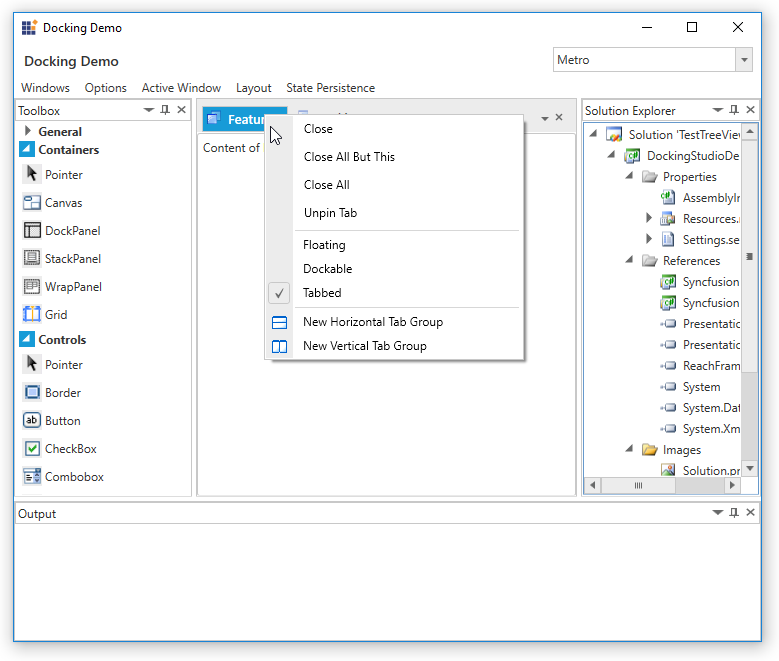
Custom context menu items for tab item
You can add the custom context menu items for tab item by using the DocumentTabItemContextMenuItems property. You can also add any level of sub menu items for custom context menu item by adding that sub CustomMenuItem to the parent CustomMenuItem. You can check or uncheck the CustomMenuItem interactively or programmatically by using the CustomMenuItem.IsChecked property.
You can collapse the default tab item context menu and show only the custom context menu items by setting the CollapseDefaultContextMenuItemsInDocumentTab property to true. The default value of CollapseDefaultContextMenuItemsInDocumentTab property is false.
<syncfusion:DockingManager
UseDocumentContainer="True"
ContainerMode="TDI"
Name="dockingManager" >
<!--Adding custom context menu items for tab items-->
<syncfusion:DockingManager.DocumentTabItemContextMenuItems>
<!--Adding custom context menu items-->
<syncfusion:CustomMenuItem Header="Menu 1"/>
<syncfusion:CustomMenuItem Header="Menu 2">
<!--Adding sub custom context menu items-->
<syncfusion:CustomMenuItem Header="SubMenu 1"/>
<syncfusion:CustomMenuItem Header="SubMenu 2" IsChecked="True"/>
<syncfusion:CustomMenuItem Header="SubMenu 3">
<!--Adding sub custom context menu items for 'SubMenu 3'-->
<syncfusion:CustomMenuItem Header="Level 2"/>
</syncfusion:CustomMenuItem>
</syncfusion:CustomMenuItem>
</syncfusion:DockingManager.DocumentTabItemContextMenuItems>
<ContentControl syncfusion:DockingManager.Header="Document.xaml"
syncfusion:DockingManager.State="Document"/>
<ContentControl syncfusion:DockingManager.Header="Document.xaml.cs"
syncfusion:DockingManager.State="Document"
syncfusion:DockingManager.ShowCloseAllButThisMenuItem="False"
syncfusion:DockingManager.ShowCloseAllMenuItem="False"
syncfusion:DockingManager.ShowCloseMenuItem="False"
syncfusion:DockingManager.CollapseDefaultContextMenuItemsInDocumentTab="True"/>
<ContentControl syncfusion:DockingManager.Header="Toolbox"
syncfusion:DockingManager.State="Dock"/>
</syncfusion:DockingManager>//Creating custom context menu items
CustomMenuItem menu1 = new CustomMenuItem();
menu1.Header = "Menu 1";
CustomMenuItem menu2 = new CustomMenuItem();
menu2.Header = "Menu 2";
//Creating custom sub context menu items
CustomMenuItem customMenuItem1 = new CustomMenuItem() { Header = "SubMenu 1" };
CustomMenuItem customMenuItem2 = new CustomMenuItem() { Header = "SubMenu 2", IsChecked = true };
CustomMenuItem customMenuItem3 = new CustomMenuItem() { Header = "SubMenu 3" };
//Adding sub menu items for 'SubMenu 3' custom context menu item
CustomMenuItem level2_customMenuItem = new CustomMenuItem() { Header = "Level 2" };
customMenuItem3.Items.Add(level2_customMenuItem);
menu2.Items.Add(customMenuItem1);
menu2.Items.Add(customMenuItem2);
menu2.Items.Add(customMenuItem3);
//Adding custom context menu items with sub menu items
dockingManager.DocumentTabItemContextMenuItems.Add(menu1);
dockingManager.DocumentTabItemContextMenuItems.Add(menu2);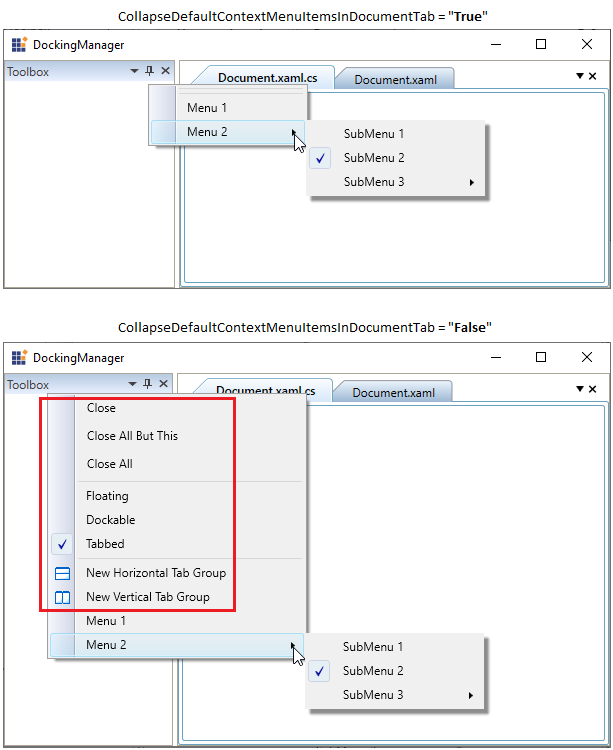
NOTE
Custom tab list context menu item
You can add the custom tab list context menu items by using the TabListContextMenuItems property. You can also add any level of sub menu items for custom tab list context menu item by adding that sub CustomMenuItem to the parent CustomMenuItem. You can check or uncheck the CustomMenuItem interactively or programmatically by using the CustomMenuItem.IsChecked property.
You can collapse the default tab list context menu items and show only the custom tab list context menu items by setting the CollapseDefaultTabListContextMenuItems property to true. The default value of CollapseDefaultTabListContextMenuItems property is false.
<syncfusion:DockingManager
UseDocumentContainer="True"
ContainerMode="TDI"
CollapseDefaultTabListContextMenuItems="True"
Name="dockingManager" >
<!--Adding custom tab list context menu items-->
<syncfusion:DockingManager.TabListContextMenuItems>
<!--Adding custom context menu items-->
<syncfusion:CustomMenuItem Header="Menu 1"/>
<syncfusion:CustomMenuItem Header="Menu 2">
<!--Adding sub custom context menu items-->
<syncfusion:CustomMenuItem Header="SubMenu 1"/>
<syncfusion:CustomMenuItem Header="SubMenu 2"/>
<syncfusion:CustomMenuItem Header="SubMenu 3">
<!--Adding sub custom context menu items for 'SubMenu 3'-->
<syncfusion:CustomMenuItem Header="Level 2"/>
</syncfusion:CustomMenuItem>
</syncfusion:CustomMenuItem>
</syncfusion:DockingManager.TabListContextMenuItems>
<ContentControl syncfusion:DockingManager.Header="Document.xaml"
syncfusion:DockingManager.State="Document"/>
<ContentControl syncfusion:DockingManager.Header="Document.xaml.cs"
syncfusion:DockingManager.State="Document"/>
<ContentControl syncfusion:DockingManager.Header="Toolbox"
syncfusion:DockingManager.State="Dock"/>
</syncfusion:DockingManager>//Disaply only the custom tab list context menu
dockingManager.CollapseDefaultTabListContextMenuItems = true;
//Creating custom tab list context menu items
CustomMenuItem menu1 = new CustomMenuItem();
menu1.Header = "Menu 1";
CustomMenuItem menu2 = new CustomMenuItem();
menu2.Header = "Menu 2";
//Creating custom sub menu tab list context menu items
CustomMenuItem customMenuItem1 = new CustomMenuItem() { Header = "SubMenu 1" };
CustomMenuItem customMenuItem2 = new CustomMenuItem() { Header = "SubMenu 2" };
CustomMenuItem customMenuItem3 = new CustomMenuItem() { Header = "SubMenu 3" };
//Adding sub menu items for 'SubMenu 3' custom tablist menu item
CustomMenuItem level2_customMenuItem = new CustomMenuItem() { Header = "Level 2" };
customMenuItem3.Items.Add(level2_customMenuItem);
menu2.Items.Add(customMenuItem1);
menu2.Items.Add(customMenuItem2);
menu2.Items.Add(customMenuItem3);
//Adding custom sub menu tab list context menu items
dockingManager.TabListContextMenuItems.Add(menu1);
dockingManager.TabListContextMenuItems.Add(menu2);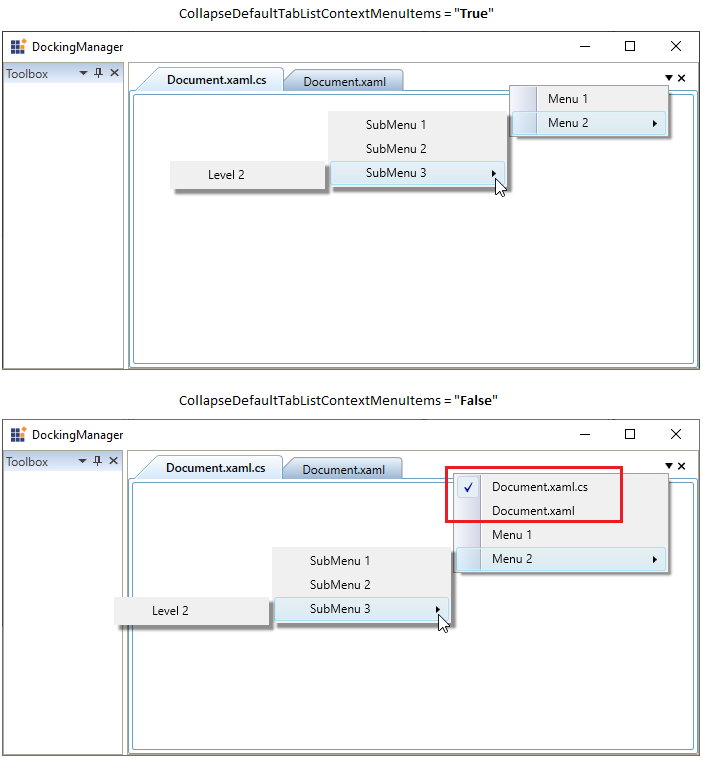
NOTE